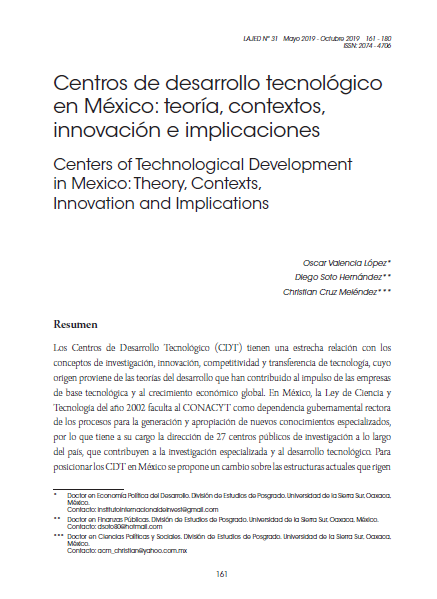Centers of Technological Development in Mexico: Theory, Contexts, Innovation and Implications
DOI:
https://doi.org/10.35319/lajed.201931350Keywords:
Development, research, Conacyt, competitiveness, technology transferAbstract
With Mexico's “Law on Science and Technology, 2002”, the government agency CONACYT became responsible for the procedures used to generate advancing specialized knowledge. To fulfill this responsibility, CONACYT manages, throughout Mexico, 27 public research centers which contribute specialized research and technological development. Technological Development Centers (CDT) are closely related to business concepts such as research, innovation, competitiveness and technology transfer. The origin of these concepts were theories on developing and promoting modern technology-based industries and global economic growth. In order to establish a Technological Development Center (CDT) in Mexico, we believe that the current procedures of CONACYT must be updated. In this report, our proposals encourage more private financial investments while promoting innovative, competitiveness strategies.
Downloads
References
Aguayo, S. (2008). México. Todo en cifras. México: Santillana.
Aström, T.; Eriksson, M.L. y Arnold, E. (2008). International Comparison of Five Institute Systems. Copenhagen: Forsknings-og Innovationsstyrelsen.
Barge-Gil, A. y Modrego-Rico, A. (2007) “Los centros tecnológicos como instrumentos de intervención pública”. En: X. Vence (editor), Crecimiento y políticas de innovación: nuevas tendencias y experiencias comparadas. Madrid: Ed. Pirámide, (241-271).
Campbell, A. y Choudhury, T. (2012). “From Smart to Cognitive Phones”. IEEE Pervasive Computing, 11(3),7-11.
Chang, H. (2002). Kicking Away the Ladder. Development Strategy in Historical Perspective. London: Anthem Press.
CTI (2018). Hacia la consolidación y desarrollo de políticas públicas en ciencia, tecnología e innovación, 2018-2024. México: UNAM.
Etzkowitz, H. y Leydesdorff, L. (1995). “The Triple Helix. University-IndustryGovernment Relations: A Laboratory for Knowledge Based Economic Development”. EASST Review, 14(1),14-19.
Gobierno de México. Foro Consultivo Científico y Tecnológico. (2015). El sector de tecnologías de la información y las comunicaciones en México y su avance: discusión actual. Ciudad de México: Foro Consultivo Científico y Tecnológico.
Gobierno de México. CONACYT (2016). Informe del estado de la ciencia, la tecnología y la innovación. México: CONACYT.
Grosse, R. (1996). “International Technology Transfer in Services”. Journal of International Business Studies, 27(4), 781-800.
List, F. ([1840] 1942). Sistema nacional de economía política. México: FCE. 12. Malerba, F. (2002). “Sectoral Systems of Innovation and Production”. Research Policy, (31), 247-264.
Mas-Verdú, F. (2008). “Does only size matter in the use of knowledge intensive services?” Small Business economic (31), 137-146.
OCDE (2006). Manual de Oslo. Madrid: Grupo TRAGSA.
OpenSignal (2015). Android fragmentation. London: OpenSignal report.
Perroux, F. (1950). “Economic Space: Theory and Applications”. The Quarterly Journal of Economics, 64(1), 89-104.
---------- (1966). “La noción de polo de crecimiento”. En: F. Perroux (ed.), La economía del siglo XX. Barcelona: Ariel, (154-167).
Porter, M. (2008). On competition. Boston: Harvard Business Press.
PWC. (2016). Global Industry 4.0 Survey. Germany:PWC.
---------- (2018). Global digital operations Study 2018 Digital Champions. Germany: PWC.
Rostow, W. (1973). Las etapas del crecimiento económico. México: Fondo de Cultura Económica.
Schumpeter, J. (1966). Capitalism, Socialism and Democracy. London: Unwin University Books.
Shaw, G. B. (1949). Back to Methuselah: Selected Plays with Prefaces. New York: Dodd, Mead.
Smith, A. ([1776] 2011). La riqueza de las naciones. Madrid: Alianza editorial.
Sowell, T. (2015). Wealth, Poverty and Politics: An International Perspective. New York: Basic Books.
Vega, L. R. (2009). “El proceso de desarrollo de productos tecnológicos entre las universidades y la MIPYMES mexicanas: una carrera de obstáculos”. Journal of Technology Management and Innovation. 4(4),120-129.






